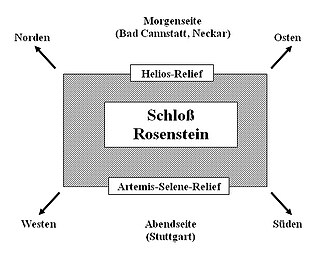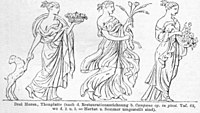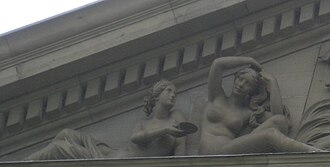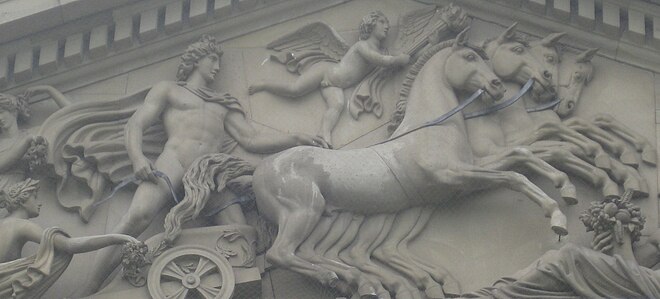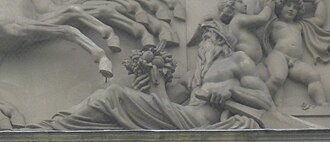Helios relief (Rosenstein Castle)
The Helios relief is a high relief by the Stuttgart sculptor Ludwig Mack (1799–1831) at Rosenstein Castle in Stuttgart, showing the sunrise with the sun god Helios .
description
| Work title | Helios relief |
| Artist | Ludwig Mack |
| Art | High relief |
| motive | Allegory of the sunrise |
| material | Sandstone |
| Dimensions | Height 2.38 m, width 12.06 m |
| Year of origin | 1830 |
| Location | Stuttgart, Rosenstein Castle, gable field on the north-eastern main portico |
The sandstone relief represents the sunrise, symbolized by the sun god Helios , who rises from the sea in the four-horse sun chariot. Phosphorus, the genius of the morning star , flies ahead of him and the three Horen follow him. He is surrounded by the god of the Neckar , playing putti , two shepherds with a goat and three sheep and two nymphs .
Mack created the relief in 1830 based on a design by the painter Johann Friedrich Dieterich . It was built into the gable of the north-eastern main portico, which forms a flat triangle with a height of 2.38 meters and a width of 12.06 meters.
Note: The portico on the evening side with the entrance to the Rosenstein Castle Museum bears the Artemis Selene relief by Friedrich Distelbarth with the approaching goddess of the moon in the gable field .
Location
|
The Rosenstein Castle, built in neoclassical style by the Italian architect Giovanni Salucci, “forms an elongated square. The whole is cut through by a higher central building, so it has 5 wings. The central building with the connected wings forms the two main facades towards Stuttgart [south-west] and towards Cannstatt or the Neckar [north-east], in the middle of which a protruding portico with 6 columns forms the main entrances. " |
|
The artistic program of the two main porticos is closely related to their spatial location (see map on the left). The portico on the morning side (= Neckar side ) of the castle, to which the arrow in the picture above points, bears the Helios relief in the gable field with the sun god Helios, who lights up the day, and the god of the Neckar. The portico on the evening side with the entrance to the Museum Schloss Rosenstein bears the Artemis Selene relief by Friedrich Distelbarth with the approaching goddess of the moon in the gable field . |
composition
The composition of the relief is divided into six image fields, which are numbered from 1 to 6 in the illustration above. The following figures are included in the image fields:
- two nymphs
- the three ears
- the sun god Helios on the four-horse sun chariot and Phosphorus, the genius of the morning star
- the god of the Neckar
- two playing putti
- two shepherds with a goat and three sheep
history
The Rosenstein castle was 1822-1830 on behalf of Württemberg King Wilhelm I to plans by the Italian architect Giovanni Salucci in neoclassical built style. The two main gable fields were to be decorated with reliefs based on designs by the painter Johann Friedrich Dieterich . In 1826 a royal decree was issued to the two sculptors Distelbarth and Mack to create the six plaster molds for the reliefs for a fee of 4,000 guilders each over a period of two years. The design should be made of cast iron, but a variant in sandstone or stucco was also discussed. In 1827 the king decided to use local sandstone. This work was also assigned to the two sculptors for a fee of 5800 guilders each and a period of four years was set for completion.
The southwestern Artemis Selene relief was made by Friedrich Distelbarth, the northeastern Helios relief by Ludwig Mack. Before the inauguration of the castle in 1830, the gable fields were temporarily filled with stucco casts. After the inauguration, the casts were not immediately exchanged for the stone reliefs that were now completed, but only in 1835.
The sandstone of the reliefs has withstood almost two centuries well. A wire netting was meanwhile stretched in front of the reliefs to protect them from pigeons.
reception
The Mack high relief seems (like its counterpart, the Artemis-Selene relief) to have only been discussed by two contemporaries (Grüneisen and Seyffer), who both saw the relief on the ground before it was built into the gable field. The lack of attention is probably due to the fact that the relief was installed high up in the air, where it is easy to overlook it and details are difficult to see, perhaps also due to the artist's unknown nature.
Ernst Eberhard Friedrich von Seyffer , the director of the Royal Building and Gardening Directorate in Stuttgart, limited himself in Seyffer 1830 to the description of the two reliefs. Carl Grüneisen, the editor of the Morgenblatt for educated estates , praised the relief in 1830: "[...] this is all expressed in a meaningful, clear and at the same time powerful way." And: "The same [Mack] has the high -Reliefs served and thus allow several figures to emerge almost entirely in the naturally round proportions of reality. This was well calculated for his local. Because, because his work only has good lighting in the first hours of the morning, he had to buy the effect with strong masses. ”( Grüneisen , page 290).
iconography
Helios- Metope : Helios with a halo emerges from the sea with his team of four
Father Rhine, Heidelberg , Hortus Palatinus
Helios. With his depiction of Helios, Mack adhered to the most common line of tradition, which depicts the sun god with a rich curly hair (or a halo around his head) as the bringer of the day, who rises from the sea with his team of four.
Listen. Since the Greeks originally only knew the three seasons of spring, summer and winter, the number of hours was also limited to three. In pictorial representations they often appear with seasonal attributes. However, these can also be missing or only partially present or all the same. In Mack's relief, two ears carry a bouquet of flowers, perhaps also the third, whose right hand is covered.
River god. River deities were usually depicted lying down, more or less naked, than men of man or old age. A cornucopia, a water jug and a paddle were often assigned to them as attributes. Mack represents the god of the Neckar as a half-clothed old man with a cornucopia and a paddle.
Details
Left
| Field of view | Image detail | description |
|---|---|---|
| 1 |
The two nymphs. In the acute angle of the left gable corner, two nymphs sit in a half-reclining position with slightly drawn-up legs on the seashore. The right nymph is completely naked, while the wrinkled, tight-fitting robe of the other nymph has slipped down to the thighs, so that the upper body, stomach and pubic area are uncovered. The left nymph with beautiful, classic facial features and an artistic, curly ponytail hairstyle turns her gaze to her sister to the right. She supports herself with her left hand on the floor, she stretches her bent right arm over to her sister and holds out a clamshell with fresh water to moisten her hair.
The naked nymph with the lovely features looks pensive and dreamy, almost like a Madonna figure. With arms stretched up and bent over her head, she tampered with her long, full head of hair, whose thick Botticellis strands she tries to tame. |
|
| 2 |
The three ears. The three Horen, the goddesses of the seasons (the Greeks originally only knew the three seasons of spring, summer and winter) rise from the waters of the sea behind Helios. The beautiful, slender virgins have classic facial features with a straight nose and forehead line, narrow mouth and almond eyes. They wear elaborate, curly hairstyles with a full, tied braid and an umbrella made of reed leaves on their foreheads.
A hearing that has just emerged from the water shows us the bare back, the robe has slipped down to the buttocks. With her right hand she puts a bouquet of flowers in Helios' carriage, while with her left she presses the right hand of her standing sister, whose armless, tight-fitting robe folds in a thousand folds and flutters violently backwards in the wind. She also holds a rich bouquet of flowers in one hand. The third of the ears is half covered by the arms of the sisters and a corner of the flowing robe of Helios. Her dress slips down one shoulder, she grabs her hair with her left arm and pensively looks into herself while her sisters watch Helios. |
center
| Field of view | description |
|---|---|
| 3 | |
|
The sun god Helios. The main motif of the relief shows in the middle of the gable field, under the roof ridge, the sun god Helios, who stands with his legs apart in his sun chariot drawn by the sun steed quadriga . The single-axle chariot consists of a low car body, which is decorated with ornate tendril ornaments, and four-spoke wheels, the spokes of which radiate towards the wheel tires like rays of sunshine.
The naked god (only a horse's tail hides his pubis like a fig leaf) is portrayed as a young man of athletic stature and perfect classical beauty. With his sinewy arms the charioteer pulls back his fiery steeds on the reins (here made of metal bands), his chest and biceps swell powerfully from the enormous exertion. The cloak around his neck billows behind him like a fluttering flag in the wind. The body, which seems to be walking, is turned towards the viewer; his face, framed by rich, long curls, shows the classic lines of the nose and forehead, the narrow mouth and the almond-shaped eyes in profile. The four sun steeds with long mane crests, pointed ears, large eyes and distended nostrils are lined up next to each other in perspective, so that their tense limbs and the facial characters of each one can be seen. In harmony with the movement, they stop in the middle of the run by leaning on their rear hooves and reaching into the air with their front hooves. Phosphorus, the genius of the morning star. Phosphorus (Latin: Lucifer ), the genius of the morning star, hovers over the back of a horse , depicted as a winged, naked putto. Rowing forward with his little legs in the air, over his left shoulder a wrinkled stole that billows in the wind, the richly curled genius holds in both hands the heavy, burning torch with which he announces the coming day. |
Right
| Field of view | Image detail | description |
|---|---|---|
| 4th |
The god of the Neckar. The god of the Neckar is personified by the figure of an old man who seems to be sitting in a boat in a half-lying position with his legs slightly drawn up. In his left hand he holds a paddle with a wide blade, in his right the cornucopia overflowing with fruit, a symbol of the life-giving power of water.
The old man, whose strong, muscular body is only covered from the hips, wears a thick beard that falls in thick strands from his cheeks, upper lip and chin and hides almost his entire face. The hair is held together by a band that ends in an umbrella made of reed leaves. |
|
| 5 |
Two playing putti. The lovely, naked putti with their plump limbs and plump bellies have thick, curly hair on their chubby heads, which is fluffy around their heads and foreheads like a wreath. They seem to be playing with each other or arguing with each other.
One putto, who faces the viewer head-on and wears a flowing scarf over his shoulder, holds a wreath of flowers above his head, which he has brought out of the reach of his little buddy who is trying to steal it. His opponent, whom we see from the side, tries to pull down one arm of the other with both hands in order to get to the coveted wreath. |
|
| 6th |
Two shepherds with a goat and three sheep. Two shepherds crouch in the acute angle of the right-hand gable corner. One is sitting in the foreground on a milking stool, his upper body upright, but leaning forward towards the goat, one leg bent and the other propped up on the ground. His simple robe barely covers his nakedness, so that the powerful upper body and the muscular arms and legs are clearly visible. He milks the apparently pregnant goat, which is turning its backside towards him. It has long-haired, shaggy fur, and the head is characterized by large, pointed ears, long, pointed horns bent back and a distinctive goatee.
Behind the goat sits the second shepherd, whose upper body only protrudes, and greets the approaching Helios with his gaze. He wears a flat, round shepherd's hat from under which his curly hair oozes out, and is clad in a robe that only leaves the forearms free. He supports the bent left arm with which he is holding a shepherd's staff on the back of the goat. In the corner, a ram and two sheep are cuddling on the floor, dozing in front of them until the sun god's ray reaches them too. |
literature
- Unpublished documents: Ludwigsburg, State Archives, E 21 Bü 264.
- Herbert Fecker : Stuttgart. The castles and their gardens . Stuttgart 1992.
- Karl Grüneisen: About the works of art of the royal country house Rosenstein near Stuttgart . In: Morgenblatt for educated stands, Kunst-Blatt. 1830 No. 73, pages 289-291.
- Rotraud Harling and Manfred Warth: Castle and Park Rosenstein. Stuttgart 1993.
- Wilhelm Heinrich Roscher (editor): detailed lexicon of Greek and Roman mythology. Leipzig 1897–1909, volume 1, 2.
- Ernst Eberhard Friedrich von Seyffer: The royal country house Rosenstein . In: Württemberg year books for patriotic history, geography, statistics and topography. 1830, pages 307-360.
- Ernst Eberhard Friedrich von Seyffer: Description of the royal country house Rosenstein. Stuttgart 1831, pages 27-30 [1] .
Web links
Individual evidence
- ↑ Seyffer 1830 , page 331.
- ↑ Dimensions in feet according to Seyffer 1831 , page 29, converted into meters (1 foot = 0.286 meters).
- ↑ Seyffer 1831 , pp. 27–29 (spelling adjusted, omissions not marked).
- ↑ Unpublished Documents No. 1–2.
- ↑ Unpublished documents No. 1, Appendix 4, No. 10 and 12. The fee included costs for laborers, tools and the construction of a correspondingly large studio, so that only 1160 guilders were left for the sculptors.
- ↑ See Fecker , pp. 87–88.
- ↑ Roscher, Volume 1,2 , Column 2728.
- ↑ The Artemis Selene relief on the other side of the castle shows the state patroness Württembergia , also with an overflowing cornucopia.
- ↑ Ludwigsburg, State Archives, E 21 Bü 264, No. 1 and 9, agree with Stuttgart, Main State Archives, E 14 Bü 192, No. 37 (without enclosures) and 45, respectively.
- ↑ The text, even the print type, seems identical to Seyffer 1830 , it is only cited here because it can be viewed on the Internet. Seyffer 1830 is significant for the dating of the relief through the footnote on page 331
Coordinates: 48 ° 48 '2.56 " N , 9 ° 12' 22.67" E


